
20 minute read
Pregnancy Loss In Alpaca
PREGNANCY LOSS IN THE ALPACA
Reproduced courtesy of Alpaca World Magazine UK
Advertisement
Losses arising from abor�on are distressing for owner and animal alike and are a financial set back. Well planned breeding programmes can be severely disrupted with knockon effects for the gene�c development of herds and breeders marke�ng ini�a�ves. Ahmed Tibary, DMV, PhD, Dipl. ACT, of the Veterinary Teaching Hospital, College of Veterinary Medicine, Washington State University, outlines some of the causes and consequences associated with this problem.
Pregnancy loss is the second most common complaint in alpaca infer�lity in my prac�ce. There is no epidemiological data on the extent of this problem. However based on records in the theriogenology service at the Veterinary Teaching Hospital, Washington State University, 7–12% of all pregnancies will be lost during the 11–12 month gesta�onal course. From a clinical point of view, pregnancy losses can be divided into three categories; early embryonic death; early fetal loss and late fetal losses.
Diagnosis of the cause of pregnancy loss is one of the most challenging aspects of infer�lity work up. It requires the services of a veterinarian with a good background in theriogenology (a veterinary speciality dealing with infer�lity, obstetrics and neonatal problems), and an excellent diagnos�c laboratory support. The objec�ve of the present ar�cle is to discuss the causes, diagnos�c approach and possible therapy for pregnancy loss in alpacas.
DEFINING THE PROBLEM: THE IMPORTANCE OF PREGNANCY DIAGNOSIS
When discussing or working up a case of pregnancy loss it is important to define the precise problem in terms of whether this is an individual female problem or a herd problem, when does the loss occur and what are the historical data of importance that happened before observa�on of the pregnancy loss. Talking about pregnancy loss suggests that a female has been diagnosed pregnant at a first examina�on and is found open at a subsequent examina�on. Therefore, of utmost importance in defining the problem is what method is used to diagnose pregnancy in the first place.
Pregnancy can be diagnosed by a variety of methods and is most commonly based on female behaviour, hormone assays and ultrasonographic examina�on of the uterus and its content. I consider ultrasonography to be the gold standard method for any examina�on for pregnancy
I consider ultrasonography to be the gold standard method for any examina�on for pregnancy. For a well-trained person, ultrasonography carries a very high accuracy (100%) star�ng at 12 days post-breeding (Figure 1) when done trans-rectally and star�ng at 45 days (Figure 2) and up to 5 months when done trans-abdominally (Figure 3).
Transabdominal ultrasonography for pregnancy evalua�on beyond 5 months is possible and highly accurate but requires shaving a large area of the abdominal wall to allow be�er visualisa�on because the fetus is very deep in the abdomen.
Ultrasonography offers the veterinarian the clinical means not only to establish a diagnosis of pregnancy but also evaluate normalcy of the pregnancy with respect of cervical tone, placental health, fetal well-being and fetal number (twins).
Figure 1: Transrectal ultrasound of a normal 12 day pregnancy in an alpaca. Arrows point to the amnio�c sac (embryonic fluid is black).
Figure 2: Transabdominal ultrasound of a normal 45 day pregnancy in an alpaca. Arrow point to the fetus (grey) within the uterus surrounded by normal fetal fluid (black).
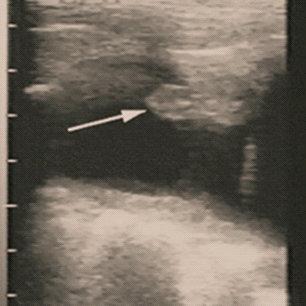
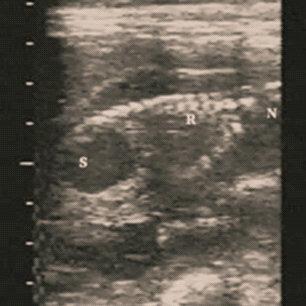
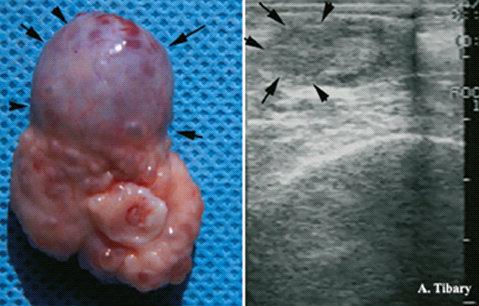
Figure 4: Corpus luteum appearance on a specimen (right) and on ultrasound (le�).
The most common hormonal assay that is used for determina�on of pregnancy status is progesterone. Scien�fic studies have shown that in order for a female to maintain pregnancy the hormone progesterone which is secreted by the corpus luteum (CL) (Figure 4) should remain high.
The corpus luteum will be the sole source of this hormone and therefore any disrup�on of its ac�vity may result in loss of pregnancy. But how high is high when progesterone is considered for pregnancy diagnosis? Most labs suggest that pregnancy is only guaranteed if the level of serum progesterone is at or above 2ng/ml. Others prefer to use a cutoff of 1.5ng/ml.
Figure 3: Transabdominal ultrasound of a normal 3 month pregnancy in an alpaca (S= fetal stomach, R= fetal rib cage, N= fetal neck).
Placental health is generally appreciated by looking at the a�achment between the maternal side (uterine lining) and the fetal side (fetal membrane; placenta, chorioallantoic). Fetal well being is determined by its growth in rela�on to gesta�on stage (using formulas correla�ng body measurements with age in days) as well as its ac�vity (movements) and its heart rate and rhythm. In addi�on the appearance of fetal fluid on ultrasound can be used to detect changes that may result in loss of a pregnancy.
Although very highly sugges�ve of pregnancy, specific behaviour towards the male (spi�ng-off) is only about 85% accurate in terms of determining pregnancy status. Many females may reject the male for other reasons and most commonly because they have high progesterone that may be due to presence of luteal structures (�ssue that produces Our ongoing research suggests that there are several sources of varia�on concerning progesterone levels in pregnant alpacas and it is not rare in our prac�ce to see pregnant alpacas with values between 0.9 and 1.5ng/ml.
Where do these varia�on come from?
Certainly some are due to sample handling errors, lab errors, but of most importance to us are other factors intrinsic to the female itself. In addi�on to these varia�ons that make progesterone use for pregnancy diagnosis not reliable there is an added factor which the presence of progesterone in non-pregnant females with persistent luteal structures on the ovaries (persistent CL or luteinized follicles). In fact presence of significant levels of progesterone in the blood should be considered only as a first step in pregnancy diagnosis and the status should be confirmed by ultrasonography.
There are other hormones (estrone sulfate, relaxin) that are used in the later part of gesta�on to evaluate the fetus and pregnancy however these are rarely used in common prac�ce.
As stated above, determining that there was indeed a pregnancy loss will primarily be based on establishing with certainty that the female was pregnant and is now open or by actually visualizing symptoms that are sugges�ve of a pregnancy loss in progress.
In many instances pregnancy loss diagnosis is posed when a female that has been diagnosed as pregnant (preferably with ultrasound) fails to develop normal third trimester signs of advanced pregnancy (increased abdominal size; visualiza�on of fetal movement) or even worse she may fail to deliver well past her an�cipated due date. In some instances, the presump�on that the pregnancy was lost is based on behavioural signs of recep�vity to the male a�er establishment of pregnancy (si�ng next a breeding pair or across from a male fence).
The best evidence of pregnancy loss is the presence of abnormal discharge from the vagina or elimina�on of the fetus and the fetal membranes. Vaginal discharges are generally obvious if the loss occurs a�er 60 days. Most pregnancy losses before this date are seldom seen because some females will just reabsorb even if they eliminate the fetus and its fluid and the signs will go unno�ced because of the smallness of the conceptus. In cases of suspicion of recent loss an inspec�on of the dung pile may reveal the presence of fetal remnants. The opposite is also possible, owners no�ce fetal or placental parts on the field, which suggests that a female has lost her pregnancy. In this par�cular case an inspec�on of the en�re group of females in that pen is warranted.
Pregnancy loss may some�mes be suspected during the process of pregnancy diagnosis. On occasion during pregnancy examina�on, evidence of disrupted fetal membrane (Figure 5), fetal heart rate, or abnormal ultrasound appearance of uterine content may suggest a non-viable pregnancy.

Sporadic Pregnancy Losses
Severe systemic diseases All
Severe nutri�onal deficiencies Lacta�ng females. Young maiden females
Stress, heat stress All groups; may be epidemic if several females are involved
Progesterone insufficiency Some females
Selenium deficiency All
Vitamin A Young females
Sporadic Drug Induced
Infec�ous Pregnancy Losses
Iodine deficiency Young females
Placental insufficiency
Cervical incompetence
Metabolic problems (hepa�c lipidosis) Older females or females with history of uterine infec�on
Females with history of dystocia
Obese females
Prostaglandin injec�ons All, any stage of pregnancy
Cor�costeroids All, any stage of pregnancy
8 way vaccines Some females may react to this
Chlamydiosis May cause abor�on storms
Figure 5: Ultrasonographic appearance of non-viable pregnancies. a) 30 days, note disrupted fetal membranes, b) 45 days and c) 3 months, no fetal fluid, no heart beat.
CAUSES OF PREGNANCY LOSSES IN ALPACAS Just like any other species, causes of pregnancy loss in alpacas are numerous (Table 1). Pregnancy loss can generally be categorised as sporadic (happening every once in a while and concern only a few females without real associa�on) or epidemic (a ‘storm’, several females losing pregnancy within a short interval of �me). Sporadic pregnancy losses are generally due to factors within the individual itself. Toxoplasmosis May cause abor�on storms
Leptospirosis May cause abor�on storms
Brucellosis Not present in the USA
Bacterial placen��s Females with bad vulvar conforma�on or recurrent vaginal prolapse during pregnancy
Twinning Some Females
Severe fetal malforma�ons Rare
Fibre produc�on High producing fine fibre animals
An example of sporadic pregnancy loss is the female that mistakenly receives a drug that causes loss of corpus luteum func�on (Table 1), or has undergone a stressful situa�on resul�ng in her losing the pregnancy (ie severe disease process, long stressful trip, heat stress). Probably the most common sporadic form of pregnancy loss is illustrated by females that tend to become pregnant rela�vely easily and then lose the pregnancy within a few weeks or cannot carry the pregnancy to term due to placental insufficiency, hormonal imbalances or gene�c predisposi�on.
Placental insufficiency is due to a lack of normal placental development resul�ng from the presence of scarred uterine �ssue or premature placental separa�on. Hormonal imbalances may be brought about by stressful condi�ons. Progesterone deficiency is suspected in many females but is hard to isolate as a primary cause of pregnancy loss.
Infec�ous causes of pregnancy losses are of special interest to large herds or herds that have no biosecurity measures. The most commonly diagnosed infec�ous causes of pregnancy losses are leptospirosis, chlamydiosis, and toxoplasmosis. These diseases may cause severe losses if they happen in an epidemic fashion.
APPROACH TO DIAGNOSIS OF THE CAUSE OF PREGNANCY LOSSES IN ALPACA

The best chance of determining the cause of pregnancy loss in the case of an observed abor�on or s�llbirth is to provide the veterinarian with all the �ssues for laboratory submission immediately. These should include the fetus and placenta (Figure 6). These �ssues should be removed and secured in plas�c bags and rushed to a veterinarian in a fresh condi�on or cooled (not frozen).
In addi�on, the veterinarian may opt to take uterine culture and blood samples from the abor�ng female(s). Obtaining these samples in good condi�on within the first 24 to 72 hours a�er abor�on greatly improves the diagnosis of the cause of pregnancy loss. In some cases the veterinarian may suggest taking blood samples from other females in the herd for comparison purposes. Always take abor�on seriously because it could be just the beginning of an abor�on storm.
The placenta is a mirror image of the uterine lining and should be kept fresh for evalua�on by a veterinarian (Figure 7). The placenta will be examined by the veterinarian for any signs of inflamma�on (placen��s) or infec�on that may be involved in the abor�on or s�ll birth (Figure 8).
The surface of the placenta will also provide informa�on on possible areas of scarring (fibrosis) which will lack the typical arrangement of �ssue (villosi�es of the microcotyledons) responsible for the transfer of nutrient between the dam and the fetus. Samples from the placenta will be taken for microscopic evalua�on (histopathology).

Figure 6: Abor�on, 6 month-old fetus and placenta from a female that aborted due to severe trace minerals deficiency. Figure 7: Alpaca placenta showing lesions on the surface.

whether progesterone decline is a result of embryonic death or that the embryo dies because of lack of progesterone. Many ar�cles s�pulate that the minimum level of progesterone in blood required for maintenance of pregnancy is 2ng/ml. However, results in an experiment in progress in our laboratory shows that many normal pregnant alpacas have progesterone concentra�on as low as 1.2ng/ml. Reports from field observa�ons indicate progesterone values as li�le as 0.6 ng/ml in alpacas that carried to term.
Figure 8: Placen��s. Thickened placenta seen by ultrasonography. This female aborted 4 days later.
The fetus is usually examined for malforma�ons, growth retarda�on or evidence of infec�ous agents. Growth retarda�on is determined by measurement of the size of the fetus and comparing it to normal growth charts. Samples taken from the stomach of the fetus will be taken for bacteriological examina�on.
The female(s) experiencing pregnancy loss at any stage of pregnancy should be isolated from the rest of the herd and examined thoroughly. The ini�al examina�on generally focuses on detec�on of any systemic diseases or nutri�onal problems that may be responsible for or a contribu�ng factor to pregnancy loss. Females in poor body condi�on or suffering from mineral deficiencies experience a higher rate of pregnancy a�ri�on, abor�on and s�llbirth.
Young females that are bred before they have reached at least 65% of the expected adult weight and size will experience a higher rate of abor�on or early pregnancy loss. Data from South America showed that females that are bred before they reach 90lbs in weight experience pregnancy loss at a rate of 40–60%. In North America, because of a higher level of care and nutri�on young females may reach and surpass this weight before they are sufficiency developed (uterus and bone structure) to be able to maintain a pregnancy.
Progesterone insufficiency is without doubt the most commonly ‘diagnosed’ and ‘treated’ disorder by several breeders and veterinarians. What do we know about progesterone deficiency? Although this is a likely cause of pregnancy loss in alpacas, it is very hard to determine These results point to a serious problem in that many alpacas may be supplemented with progesterone when they do not need it and that there may be some errors in reported progesterone values. It is my clinical opinion that progesterone should be >1ng/ml for a pregnancy to be maintained. Low progesterone values reported in pregnant alpacas may be due to sample handling or to laboratory errors. Other factors affec�ng progesterone values, due to the individual female, are being inves�gated currently in our laboratory.
Pregnancy loss may also occur in alpacas due to stressful condi�ons (heat stress, re-adjustment to a new environment …). These situa�ons generally remain hypothe�cal and their diagnosis will be based on historical data (was there a change in management or handling in the days preceding pregnancy loss?). Another form of ‘stress’ that I suspect may cause midterm to late-term abor�on in alpacas is the compe��on between fibre produc�on and fetal growth.
Treatment with cor�coisteroids (even topical eye ointment), some eight way vaccines and administra�on of the drug prostaglandin F2 alpha or its analogues (normally used for treatment of retained CL’s) will cause abor�on.
Repeated pregnancy loss between 30 days and 8 months due to twins has been reported to me on several females. Double ovula�ons and twin pregnancies are not rare in alpacas. There seems to be an increase in these twinnings probably because of increased nutri�onal plan and improvement in our ability to detect the twins by ultrasonography. This is an added benefit of using ultrasound for pregnancy diagnosis rather that just progesterone levels or behavioural manifesta�ons.
Late twin abor�on will cause excessive �me loss and added hardship for the abor�ng female with increased dystocia and postpartum complica�ons which may jeopardize the future reproduc�ve life of the dam. Therefore early diagnosis of twin ovula�ons and twins is highly recommended par�cularly in those females that have had already an incidence of twin pregnancy. Many alpacas that start their pregnancy as twins will reduce to a singleton and will go on to have a normal pregnancy to term. I recommend that any female that has not reduced the number of fetuses on her own by day 35 of pregnancy be aborted at this stage.
Preven�on of pregnancy losses in alpacas requires several measures at the herd level and at the individual level.
At the herd level, preven�on of outbreaks of losses requires development, with the a�ending veterinarian, of strict and detailed biosecurity measures as well as a good herd health (proper regular deworming and vaccina�on) and nutri�onal (regular evalua�on of feed quality, trace mineral levels and body condi�on of animals) programmes. Vaccina�on against some of the abor�on causing diseases such as Chlamydiosis and leptospirosis may be indicated in high risk situa�ons. Gene�c selec�on programmes may be involved in overall reproduc�ve performance in alpacas and should always be kept in mind.
On an individual level, high risk pregnancies or female at high risk of losing their pregnancy a�er breeding should be iden�fied early. This group should include any female that has had a history of pregnancy loss, obstetrical problems or uterine infec�ons. All these condi�on can lead, if not treated properly, to uterine fibrosis (scarring) which will not be compa�ble with normal placental func�on and result in early fetal loss or abor�on. Uterine biopsy may be indicated in some females in order to determine if they have these chronic changes in the uterus. The use of ultrasonography is recommended for early pregnancy diagnosis and monitoring of pregnancy. Abor�ons can be due to infec�ous diseases and each should be taken seriously, working with the veterinarian immediately a�er no�cing an abor�on. Submi�ng fetal, placental and dam samples to a laboratory improves the odds of determining the cause.
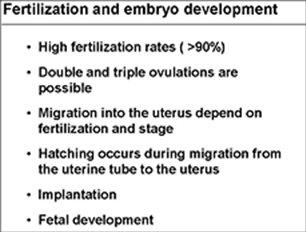
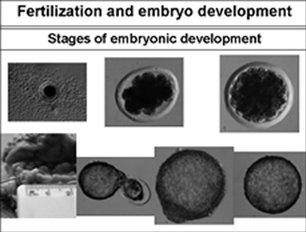
The best way to prevent pregnancy loss and maximise the reproduc�ve career of a female alpaca is to adopt strict measure in the preven�on of uterine infec�ons and birthing problems which are responsible for development of these chronic changes. Uterine infec�ons are best prevented by avoiding repeated unnecessary breeding. If uterine infec�on occurs they should be promptly and adequately treated. Obstetrical manipula�ons should be done by a knowledgeable person observing strict hygiene measures.
High risk females should be monitored closely during pregnancy. If progesterone supplementa�on is the op�on taken, fetal viability and well being should be verified regularly to avoid maintaining a dead fetuses in the uterus. Several types of progestogens (progesterone or progesterone like hormones) are available on the market. Although, anecdotal success with some of these are reported by breeders and veterinarians there has been no scien�fic research to demonstrate their efficacy in preven�on of pregnancy loss nor the manner by which they should be used. Sexual rest of older female or females with uterine fibrosis for a few months may improve their chances in carrying to term.
In conclusion, pregnancy loss in alpacas is rela�vely common par�cularly in popula�ons at high risk (older females, maiden underdeveloped females, females with a history of uterine infec�on or obstetrical problems). Management measures to reduce the incidence of these problems and ‘prepare’ females for breeding is the first step in preven�on of losses.

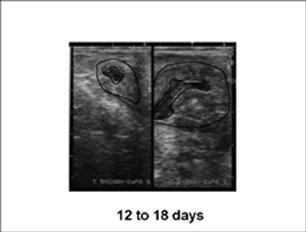
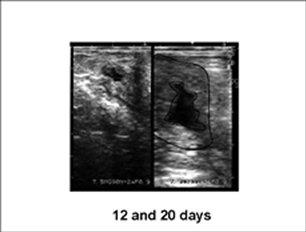
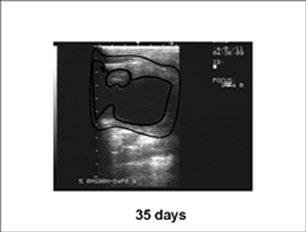
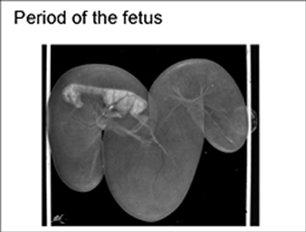
Acknowledgement I am indebted to several colleagues as well as breeders from all over the USA and par�cularly WA, ID, OR, CA, CO and MT, who share with me their clinical observa�ons and entrust me with care for their alpacas.
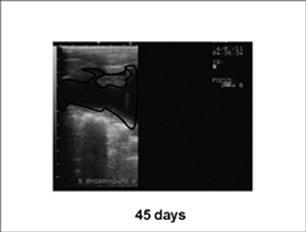
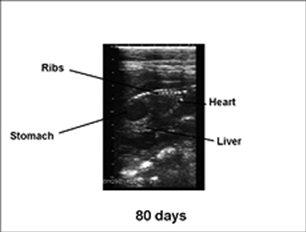

Websites for Farmers

A website today is the basis of most business marketing - a website helps you sell your livestock, your produce or services to the widest audience possible.
WE KNOW & UNDERSTAND RURAL BUSINESSES Here at Oak Grove Graphics we understand what it takes to make a great website for farmers, because we are also farmers as well as web designers! We offer you web site op�ons to suit you, from easy self maintained sites to we do it all for you op�ons, we design sites that are a�rac�ve, func�onal and individual like your business. From the land to the sea, if your business is rural we can help you promote your business locally or Australia wide.

AFFORDABLE PRICES Our country prices are some of the best you will find anywhere. Contact us for a free no obliga�on quote and down to earth conversa�on about how we can help your business grow through marke�ng your business on the internet.












ADVERTISING RATES
Camelid Connections magazine offers you affordable advertising for your camelid related business, event or stud. Contact us to secure your advertising space in future publications.
● The affordable alternative for all your camelid related advertising ● All adverts have a hyperlink directly to your website or email - one click & potential customers can connect with you ● Camelid Connections magazine is a FREE online publication available as a subscription or download from our website ● Back issues will always be available online so your advert has a long ‘shelf life’ ● Camelid Connections offers readers a wide variety of quality articles of interest to attract a broad audience
Advertising Rates*
Full A4 Page $360 (210mm x 297mm No bleed required)
210mm Half Page $185 (190mm x 133mm)
190mm
297mm 133mm Quarter Page $95 (93mm x 133mm) Business Card $55 (93mm x 65mm)
93mm
133mm 93mm
65mm
Classified Listing $36 Max - 50 words + contact details
● Package rates for prepaid advertisements in 3 issues of Camelid Connections receive a 10% discount. ● Double page spread receives a 25% discount (no additonal discounts apply) ● Inside front cover and opposite page attract a 10% loading. ● Camelid Connections magazine will be a quarterly publication commencing in September 2017* ● Advertising needs to be provided as a PDF or JPG to specifications listed above. ● Other advert configurations considered - ask us for a quote
To book advertising or for further details contact either:
● Julie McClen - Graphic Designer Ph: 02 6493 2036 Email: julie@camelidconnections.com.au










